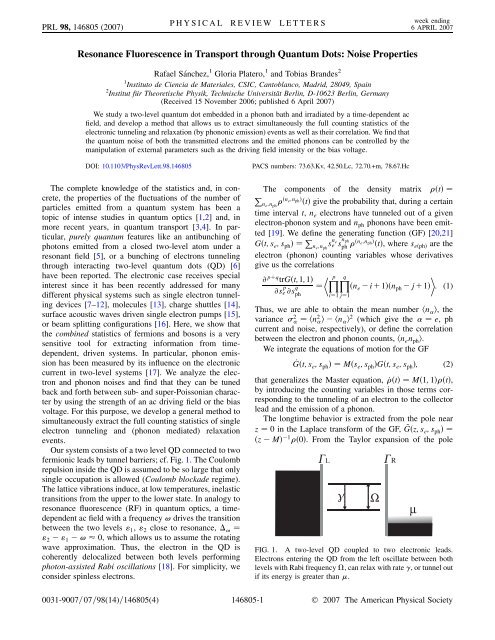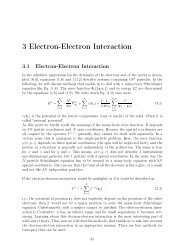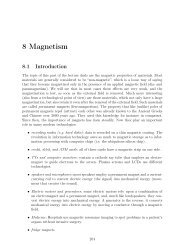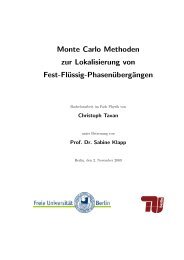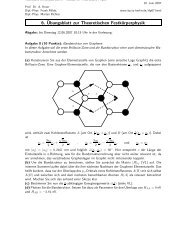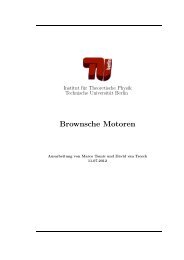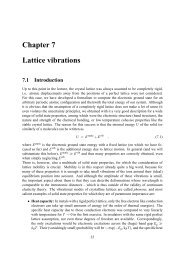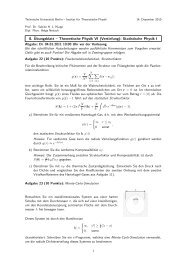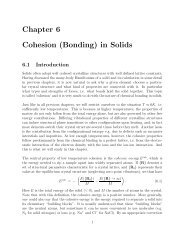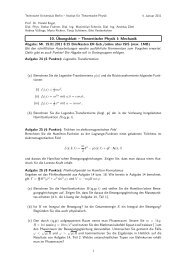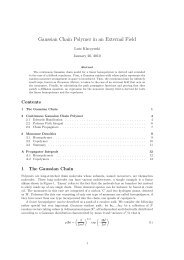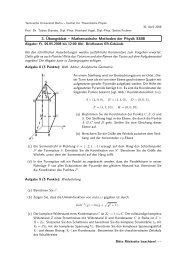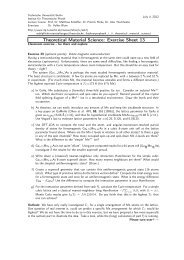Resonance Fluorescence in Transport through Quantum Dots ...
Resonance Fluorescence in Transport through Quantum Dots ...
Resonance Fluorescence in Transport through Quantum Dots ...
You also want an ePaper? Increase the reach of your titles
YUMPU automatically turns print PDFs into web optimized ePapers that Google loves.
PRL 98, 146805 (2007)<br />
PHYSICAL REVIEW LETTERS week end<strong>in</strong>g<br />
6 APRIL 2007<br />
<strong>Resonance</strong> <strong>Fluorescence</strong> <strong>in</strong> <strong>Transport</strong> <strong>through</strong> <strong>Quantum</strong> <strong>Dots</strong>: Noise Properties<br />
Rafael Sánchez, 1 Gloria Platero, 1 and Tobias Brandes 2<br />
1 Instituto de Ciencia de Materiales, CSIC, Cantoblanco, Madrid, 28049, Spa<strong>in</strong><br />
2 Institut für Theoretische Physik, Technische Universität Berl<strong>in</strong>, D-10623 Berl<strong>in</strong>, Germany<br />
(Received 15 November 2006; published 6 April 2007)<br />
We study a two-level quantum dot embedded <strong>in</strong> a phonon bath and irradiated by a time-dependent ac<br />
field, and develop a method that allows us to extract simultaneously the full count<strong>in</strong>g statistics of the<br />
electronic tunnel<strong>in</strong>g and relaxation (by phononic emission) events as well as their correlation. We f<strong>in</strong>d that<br />
the quantum noise of both the transmitted electrons and the emitted phonons can be controlled by the<br />
manipulation of external parameters such as the driv<strong>in</strong>g field <strong>in</strong>tensity or the bias voltage.<br />
DOI: 10.1103/PhysRevLett.98.146805<br />
PACS numbers: 73.63.Kv, 42.50.Lc, 72.70.+m, 78.67.Hc<br />
The complete knowledge of the statistics and, <strong>in</strong> concrete,<br />
the properties of the fluctuations of the number of<br />
particles emitted from a quantum system has been a<br />
topic of <strong>in</strong>tense studies <strong>in</strong> quantum optics [1,2] and, <strong>in</strong><br />
more recent years, <strong>in</strong> quantum transport [3,4]. In particular,<br />
purely quantum features like an antibunch<strong>in</strong>g of<br />
photons emitted from a closed two-level atom under a<br />
resonant field [5], or a bunch<strong>in</strong>g of electrons tunnel<strong>in</strong>g<br />
<strong>through</strong> <strong>in</strong>teract<strong>in</strong>g two-level quantum dots (QD) [6]<br />
have been reported. The electronic case receives special<br />
<strong>in</strong>terest s<strong>in</strong>ce it has been recently addressed for many<br />
different physical systems such as s<strong>in</strong>gle electron tunnel<strong>in</strong>g<br />
devices [7–12], molecules [13], charge shuttles [14],<br />
surface acoustic waves driven s<strong>in</strong>gle electron pumps [15],<br />
or beam splitt<strong>in</strong>g configurations [16]. Here, we show that<br />
the comb<strong>in</strong>ed statistics of fermions and bosons is a very<br />
sensitive tool for extract<strong>in</strong>g <strong>in</strong>formation from timedependent,<br />
driven systems. In particular, phonon emission<br />
has been measured by its <strong>in</strong>fluence on the electronic<br />
current <strong>in</strong> two-level systems [17]. We analyze the electron<br />
and phonon noises and f<strong>in</strong>d that they can be tuned<br />
back and forth between sub- and super-Poissonian character<br />
by us<strong>in</strong>g the strength of an ac driv<strong>in</strong>g field or the bias<br />
voltage. For this purpose, we develop a general method to<br />
simultaneously extract the full count<strong>in</strong>g statistics of s<strong>in</strong>gle<br />
electron tunnel<strong>in</strong>g and (phonon mediated) relaxation<br />
events.<br />
Our system consists of a two level QD connected to two<br />
fermionic leads by tunnel barriers; cf. Fig. 1. The Coulomb<br />
repulsion <strong>in</strong>side the QD is assumed to be so large that only<br />
s<strong>in</strong>gle occupation is allowed (Coulomb blockade regime).<br />
The lattice vibrations <strong>in</strong>duce, at low temperatures, <strong>in</strong>elastic<br />
transitions from the upper to the lower state. In analogy to<br />
resonance fluorescence (RF) <strong>in</strong> quantum optics, a timedependent<br />
ac field with a frequency ! drives the transition<br />
between the two levels " 1 , " 2 close to resonance, !<br />
" 2 " 1 ! 0, which allows us to assume the rotat<strong>in</strong>g<br />
wave approximation. Thus, the electron <strong>in</strong> the QD is<br />
coherently delocalized between both levels perform<strong>in</strong>g<br />
photon-assisted Rabi oscillations [18]. For simplicity, we<br />
consider sp<strong>in</strong>less electrons.<br />
The components of the density matrix t<br />
P<br />
n e ;n ph<br />
n e ;n ph<br />
t give the probability that, dur<strong>in</strong>g a certa<strong>in</strong><br />
time <strong>in</strong>terval t, n e electrons have tunneled out of a given<br />
electron-phonon system and n ph phonons have been emitted<br />
[19]. We def<strong>in</strong>e the generat<strong>in</strong>g function (GF) [20,21]<br />
G t; s e ;s ph<br />
Pn e ;n ph<br />
s n e<br />
e s n ph n e ;n ph<br />
ph<br />
t , where s e ph are the<br />
electron (phonon) count<strong>in</strong>g variables whose derivatives<br />
give us the correlations<br />
Y p<br />
Y q<br />
@ p q trG t;1;1<br />
@s p e @s q n e i 1 n ph j 1 : (1)<br />
ph i 1 j 1<br />
Thus, we are able to obta<strong>in</strong> the mean number hn i, the<br />
variance<br />
2<br />
hn 2 i hn i 2 (which give the e, ph<br />
current and noise, respectively), or def<strong>in</strong>e the correlation<br />
between the electron and phonon counts, hn e n ph i.<br />
We <strong>in</strong>tegrate the equations of motion for the GF<br />
G_<br />
t; s e ;s ph M s e ;s ph G t; s e ;s ph ; (2)<br />
that generalizes the Master equation, _ t M 1; 1 t ,<br />
by <strong>in</strong>troduc<strong>in</strong>g the count<strong>in</strong>g variables <strong>in</strong> those terms correspond<strong>in</strong>g<br />
to the tunnel<strong>in</strong>g of an electron to the collector<br />
lead and the emission of a phonon.<br />
The longtime behavior is extracted from the pole near<br />
z 0 <strong>in</strong> the Laplace transform of the GF, ~G z; s e ;s ph<br />
z M 1 0 . From the Taylor expansion of the pole<br />
FIG. 1. A two-level QD coupled to two electronic leads.<br />
Electrons enter<strong>in</strong>g the QD from the left oscillate between both<br />
levels with Rabi frequency , can relax with rate , or tunnel out<br />
if its energy is greater than .<br />
0031-9007=07=98(14)=146805(4) 146805-1 © 2007 The American Physical Society
PRL 98, 146805 (2007)<br />
PHYSICAL REVIEW LETTERS week end<strong>in</strong>g<br />
6 APRIL 2007<br />
z 0<br />
Pm;n>0c mn s e 1 m s ph 1 n , we obta<strong>in</strong> G t;s e ;s ph<br />
g s e ;s ph e z 0t and the central moments<br />
hn e ph i<br />
2<br />
e ph<br />
@g 1; 1<br />
@s e ph<br />
c 10 01 t; (3a)<br />
@ 2 g 1; 1<br />
@s 2 e ph<br />
@g 1; 1<br />
@s e ph<br />
2<br />
c 10 01 2c 20 02 t; (3b)<br />
or the electron-phonon correlation (not discussed here),<br />
given by<br />
hn e n ph i<br />
hn e ihn ph i<br />
@ 2 g 1; 1<br />
@s e @s ph<br />
c 11 t: (4)<br />
Higher moments can be straightforwardly obta<strong>in</strong>ed by this<br />
formalism. In the large time asymptotic limit, all the<br />
<strong>in</strong>formation is <strong>in</strong>cluded <strong>in</strong> the coefficents c mn . Then, the<br />
Fano factor is F e ph 1 2c 20 02 =c 10 01 so the sign of<br />
the second term <strong>in</strong> the right-hand side def<strong>in</strong>es the sub-<br />
(F1) Poissonian character of the noise.<br />
We describe our system by the Hamiltonian<br />
^H t i" i ^d y i<br />
P<br />
^d i 2 e i!t ^d y ^d 2 1 H:c:<br />
P<br />
Q! Q ^a y Q ^a P ^d Q Q Q y ^d P<br />
2 1 ^a Q H:c: k " k ^c y k ^c k<br />
P<br />
k iV c y k<br />
^d i H:c: , where ^a Q , ^c k , and ^d i are annihilation<br />
operators of phonons and electrons <strong>in</strong> the leads and <strong>in</strong><br />
the QD, respectively. Writ<strong>in</strong>g the density matrix as a<br />
vector, 00; 11; 12; 21; 22 T , the equation of motion<br />
of the GF (2) is described, <strong>in</strong> the Born-Markov approximation,<br />
by the matrix<br />
0<br />
2 L 1 2 R s e 1 R 0 0 s<br />
1<br />
e 2 R<br />
L se 1 1 R 1 R i 2<br />
i 2<br />
s ph<br />
1 2 R<br />
M s e ;s ph 0 i 2 2<br />
i ! 0 i 2<br />
B<br />
@<br />
C<br />
; (5)<br />
1 2 R<br />
0 i 2<br />
0<br />
2<br />
i ! i 2<br />
A<br />
L se 1 2 R 0 i 2<br />
i 2 2 R<br />
where 2 j " 2 " 1<br />
j 2 is the spontaneous phonon emission<br />
rate, 2 jV j 2 is the tunnel<strong>in</strong>g rate <strong>through</strong> the<br />
contact , is the Rabi frequency, which is proportional<br />
to the <strong>in</strong>tensity of the ac field, and i f " i 1<br />
e " i 1 and i 1 i weight the tunnel<strong>in</strong>g of electrons<br />
between the right lead (with a chemical potential )<br />
and the state i <strong>in</strong> the QD. The Fermi energy of the left lead<br />
is considered <strong>in</strong>f<strong>in</strong>ite, so no electrons can tunnel from the<br />
QD to the left lead. All the parameters <strong>in</strong> these equations,<br />
except the sample-depend<strong>in</strong>g coupl<strong>in</strong>g to the phonon bath,<br />
can be externally manipulated. In the limit L R ! 0, we<br />
recover the pure RF case for the statistics of the emitted<br />
phonons [20],<br />
F ph i 0 1<br />
2 2 3 2 4 2 !<br />
2<br />
2 2 4 2 ! 2 ; (6)<br />
yield<strong>in</strong>g the famous sub-Poissonian noise result at resonance<br />
( ! 0). In the follow<strong>in</strong>g, we will restrict ourselves<br />
to the resonant case.<br />
Electron noise.—By tun<strong>in</strong>g , we control the tunnel<strong>in</strong>g<br />
of electrons from the two levels. Let us first consider the<br />
nondriven case ( 0). If
PRL 98, 146805 (2007)<br />
Fe<br />
2.5<br />
2.25<br />
2<br />
1.75<br />
1.5<br />
1.25<br />
1<br />
0.75<br />
Fe<br />
1.8 2<br />
1.6<br />
1.4<br />
1.2<br />
a<br />
PHYSICAL REVIEW LETTERS week end<strong>in</strong>g<br />
6 APRIL 2007<br />
0.8 1<br />
0.6<br />
0.4 0.5 0.6<br />
µ<br />
0.7 0.8<br />
Fe<br />
2.5<br />
2.25<br />
2<br />
1.75<br />
1.5<br />
1.25<br />
1<br />
0.75<br />
Fe<br />
b<br />
1.8<br />
1.6<br />
1.4<br />
1.2<br />
1<br />
0.8<br />
0.6<br />
0.4 0.5 0.6<br />
µ<br />
0.7 0.8<br />
0 2 4 6 8 10 12 14<br />
γ<br />
0 1 2 3 4 5<br />
FIG. 2. Electron Fano factor as a function of (a) ~ = for ~ = 0 ( L=R) and (b) ~ for ~ 0:1 for different<br />
chemical potentials: <br />
" 2 ) cf. Fig. 3. It can be easily seen that the noise<br />
p<br />
suppression<br />
for this last case is largest when = 2 . Thus, <strong>in</strong><br />
the more <strong>in</strong>terest<strong>in</strong>g <strong>in</strong>termediate regime, " 1 < " 2 (dotted l<strong>in</strong>e). In the large-bias case, the noise always<br />
<strong>in</strong>creases with ~ and becomes super-Poissonian (<strong>in</strong> this concrete<br />
configuration) for ~ > 4:046. In the case >" 2 , there is a<br />
pronounced m<strong>in</strong>imum at ~ p<br />
1= 2 typical of the RF. The case<br />
" 1 <
PRL 98, 146805 (2007)<br />
0.8<br />
0.7<br />
PHYSICAL REVIEW LETTERS week end<strong>in</strong>g<br />
6 APRIL 2007<br />
large-bias regime for > 4 3 2 R<br />
2<br />
L = R 13<br />
11 R L 3 R R 1=2 (see Fig. 3).<br />
Jo<strong>in</strong><strong>in</strong>g both studies, it is possible to f<strong>in</strong>d different<br />
regions where the electron and phonon noise show all the<br />
sub and super-Poissonian comb<strong>in</strong>ations except the bunch<strong>in</strong>g<br />
of both electrons and phonons, s<strong>in</strong>ce <strong>in</strong> the low <strong>in</strong>tensities<br />
regime, where the electron noise tends to be super-<br />
Poissonian, the phonon noise is sub-Poissonian (strictly<br />
Poissonian for 0), see Fig. 4.<br />
In conclusion, we propose a solid-state, transport version<br />
of resonance fluorescence (driven two-level quantum dot<br />
with phonon emission), where the noise for both the transferred<br />
electronic current and the emitted phonons can be<br />
experimentally controlled by tun<strong>in</strong>g the transport (chemical<br />
potential [7]) and optics (ac field <strong>in</strong>tensity) parameters.<br />
We found various regimes show<strong>in</strong>g different comb<strong>in</strong>ations<br />
of sub and super-Poissonian electron and phonon Fano<br />
factors. Although not discussed here, our technique can<br />
also be applied to driven electron-phonon systems with<br />
higher complexity such as double quantum dots [23], and<br />
to obta<strong>in</strong> higher moments and correlations between electron<br />
and phonon distributions, which will be the scope of a<br />
future work.<br />
We thank E. Schöll and G. Kießlich for discussions.<br />
Work supported by the M. E. C. of Spa<strong>in</strong> <strong>through</strong> Grant<br />
No. MAT2005-00644 and the UE network Grant<br />
No. MRTN-CT-2003-504574. R. S. was supported by<br />
CSIC-Programa I3P, cof<strong>in</strong>anced by Fondo Social Europeo.<br />
µ<br />
0.6<br />
0.5<br />
0.4<br />
0 2 4 6 8 10 12<br />
FIG. 4. Color plot show<strong>in</strong>g the different regions where one can<br />
f<strong>in</strong>d F e , F ph 1 (white, appear<strong>in</strong>g only for ~ 0), F e < 1,<br />
F ph 1 (light gray), F e 1, F ph < 1 (dark gray), and F e , F ph <<br />
1 (black) by tun<strong>in</strong>g and ~ , for ~ 1.<br />
[1] R. J. Glauber, Phys. Rev. Lett. 10, 84 (1963); P. L. Kelley<br />
and W. H. Kle<strong>in</strong>er, Phys. Rev. 136, A316 (1964); M. O.<br />
Scully and W. E. Lamb, Jr., ibid. 179, 368 (1969); R. J.<br />
Cook, Phys. Rev. A 23, 1243 (1981); R. J. Cook, Opt.<br />
Commun. 35, 347 (1980).<br />
[2] I. Djuric and C. P. Search, Phys. Rev. B 74, 115327<br />
(2006).<br />
[3] L. S. Levitov and G. B. Lesovik, Pis’ma Zh. Eksp. Teor.<br />
Fiz. 58, 225 (1993) [JETP Lett. 58, 230 (1993)]; D. A.<br />
Bagrets and Yu. V. Nazarov, Phys. Rev. B 67, 085316<br />
(2003).<br />
[4] Ya. M. Blanter and M. Büttiker, Phys. Rep. 336, 1 (2000);<br />
S. Kohler et al., ibid. 406, 379 (2005).<br />
[5] L. Mandel, Opt. Lett. 4, 205 (1979).<br />
[6] W. Belzig, Phys. Rev. B 71, 161301(R) (2005); I. Djuric<br />
et al., Appl. Phys. Lett. 87, 032105 (2005); G. Kießlich<br />
et al., Phys. Rev. B 68, 125320 (2003).<br />
[7] S. Gustavsson et al., Phys. Rev. Lett. 96, 076605 (2006);<br />
S. Gustavsson et al., Phys. Rev. B 74, 195305 (2006).<br />
[8] Y. Utsumi et al., Phys. Rev. Lett. 96, 086803 (2006).<br />
[9] G. Kießlich et al., Phys. Rev. B 73, 033312 (2006).<br />
[10] I. Djuric et al., J. Appl. Phys. 99, 063710 (2006).<br />
[11] C. W. Groth et al., Phys. Rev. B 74, 125315 (2006).<br />
[12] E. V. Sukhorukov et al., Nature Phys. 3, 243 (2007).<br />
[13] A. Thielmann et al., Phys. Rev. B 71, 045341 (2005).<br />
[14] F. Pistolesi, Phys. Rev. B 69, 245409 (2004).<br />
[15] A. M. Rob<strong>in</strong>son et al., Phys. Rev. Lett. 95, 247202 (2005).<br />
[16] Y. Chen et al., Phys. Rev. Lett. 97, 066604 (2006).<br />
[17] T. Fujisawa et al., Science 282, 932 (1998).<br />
[18] G. Platero and R. Aguado, Phys. Rep. 395, 1 (2004).<br />
[19] M. B. Plenio and P. L. Knight, Rev. Mod. Phys. 70, 101<br />
(1998); S. A. Gurvitz and Ya. S. Prager, Phys. Rev. B 53,<br />
15932 (1996).<br />
[20] D. Lenstra, Phys. Rev. A 26, 3369 (1982).<br />
[21] B. Dong et al., Phys. Rev. Lett. 94, 066601 (2005).<br />
[22] S. Hershfield et al., Phys. Rev. B 47, 1967 (1993);<br />
G. Iannaccone et al., ibid. 55, 4539 (1997).<br />
[23] T. Brandes et al., Phys. Rev. B 69, 205326 (2004);<br />
R. Aguado and T. Brandes, Phys. Rev. Lett. 92, 206601<br />
(2004); N. Lambert et al., Phys. Rev. B 75, 045340 (2007).<br />
146805-4


